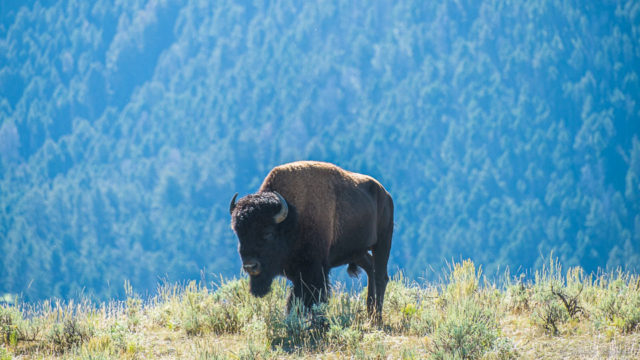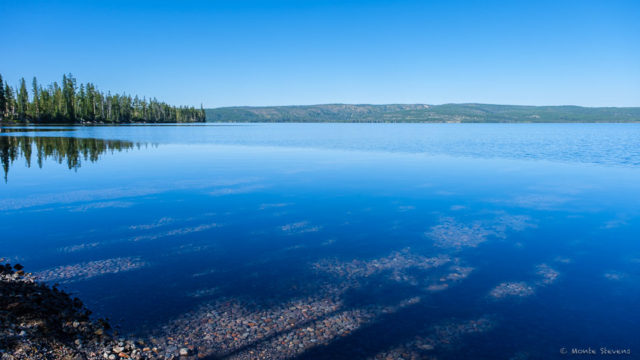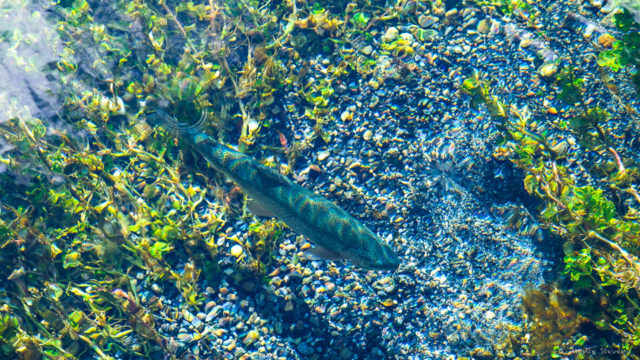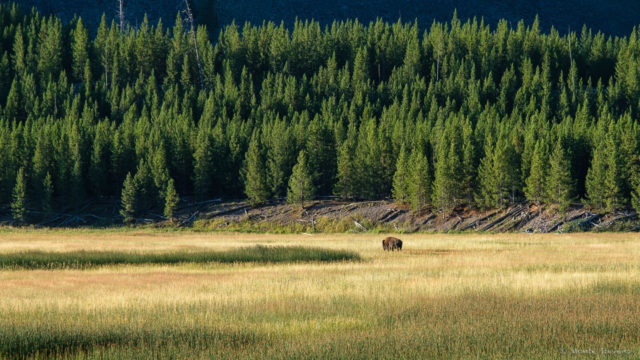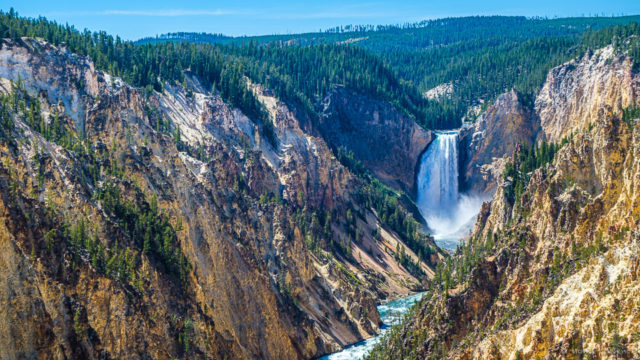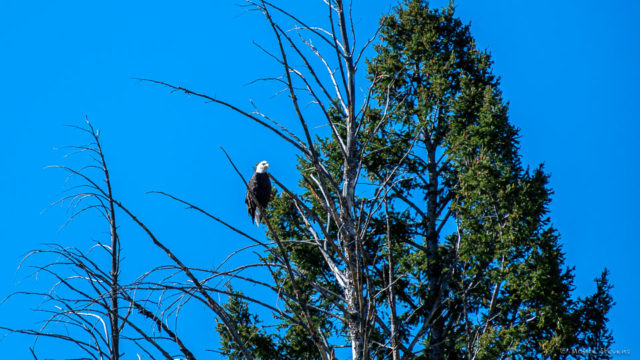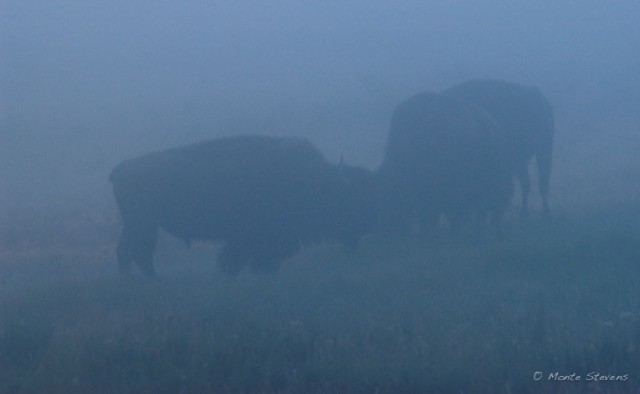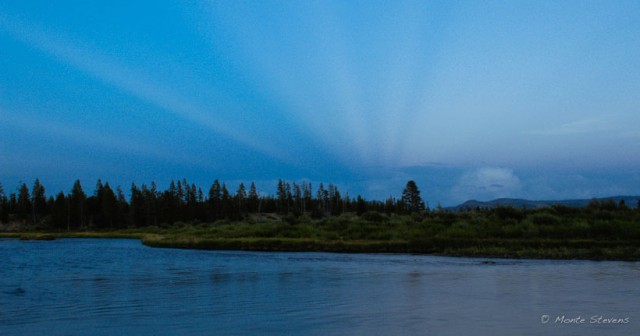Bison are so iconic of Yellowstone National Park, and the Black Hills. They appear peaceful, unconcerned, even lazy, as in this image, yet they may attack anything, often without warning or apparent reason. They can move at speeds up to 35 mph and cover long distances at a lumbering gallop. So make sure you can outrun the person you are with! As I look at this image I wonder how many photographs have been taken of this bison.
-
-
Clear Blue Waters
One thing I noticed while on this trip to Yellowstone was how clear and clean the waters were. This was true of both lakes and rivers. Big Springs is a first-magnitude spring located in Island Park, Idaho in Fremont County. It produces over 120 million gallons of water each day. Looking into that spring water was breathtaking, it was so clear. The spring is also famous for its large rainbow trout which congregate at the foot of the bridge waiting to be fed by the tourists. And no fishing allowed. We didn’t feed them but took it all in. The above image is along the shoreline of Lewis Lake in Yellowstone National Park. You can still see the bottom 15 feet from shore. The bottom image is of one of the rainbow trout taken from the bridge at Big Springs.
-
Hard to imagine…
American Bison once numbered in the millions, perhaps between 25 million and 60 million by some estimates, and they were possibly the most numerous large land animal on earth. However, by the late 1880s, they had been hunted to near extinction throughout North America. The Yellowstone Park bison herd was the last free-ranging bison herd in the United States being the only place where bison were not extirpated. The Yellowstone Park bison herd is descended from a remnant population of 23 individual bison that survived the mass slaughter of the 19th century in the Pelican Valley of Yellowstone Park. To assist in the species’ revival, in 1896 the United States government obtained one bull and seven cows from the Lincoln Park Zoo bison herd for Yellowstone. In 1902, a captive herd of 21 Goodnight plains bison was introduced to the park and then moved to the Lamar Valley and managed as livestock until the 1960s, when a policy of natural regulation was adopted by the park. Yellowstone National Park has large areas of alpine meadows and grass prairie and this provides a nearly optimum environment for American bison who live in river valleys, and on prairies and plains. Their typical habitat is open or semi-open grasslands, as well as sagebrush grasslands, semi-arid lands, and scrublands. Some lightly wooded areas are also known historically to have supported bison. Bison will also graze in hilly or mountainous areas where the slopes are not steep. It’s hard to imagine those numbers of bison especially when you look at the lone bison in the above image. (Information from Wikipedia.)
-
You had to be there!!
“You can only appreciate nature by feeling and seeing it with the heart and the eyes of a child.”
Michael Bassey JohnsonI would not be able to look myself in the mirror if I visited Yellowstone National Park without a photograph of the lower and upper falls of the Grand Canyon of the Yellowstone. I got both! Crowds were small at Artists Point due to the time of year. Without crowds I was able to just stand there watching, listening, experiencing the awe and wonder of it all. I took this photograph about 2:00 pm and that’s why the lighting is flat, but I also know any image would fail to express the experience. You had to be there!!! The waterfall captures most people’s attention but the canyon with those precipitous jagged cliffs and that yellow rock cause me stand speechless while listening to the sound of the waterfalls power echo in the canyon. I already wanna go back.
-
A Day in Yellowstone Park
Monday was a 12 hour day spent in Yellowstone Park. We were able to get a pass into Lamar Valley as it is closed at the Northeast Entrance. They are limiting the amount of traffic while they repair roads. The pass only gave us access from Tower Junction to Slough Creek. That was enough for us to get photos of bison, antelope, this eagle and the beauty of of the park. Here is a link to a map and video of the damage to the roads within the park from the floods in June.
For those who are into numbers, I drove a total of 1,222 miles and averaged 29.8 miles to the gallon. And, for those who are into plays, we were able to see the musical Bright Star at a theater in West Yellowstone called The Play Mill Theatre on Saturday evening. One heck of a play!
-
Bison
This is from 2003 and a trip made to Yellowstone National Park. Lamar Valley, one of my favorite places in the park.
-
It’s a time for ….
It is light that reveals, light that obscures, light that communicates. It is light I “listen” to. The light late in the day has a distinct quality, as it fades toward the darkness of evening. After sunset there is a gentle leaving of the light, the air begins to still, and a quiet descends. I see magic in the quiet light of dusk. I feel quite, yet intense energy in the natural elements of our habitat. A sense of magic prevails. A sense of mystery. It is a time for contemplation, for listening – a time for making photographs. – John Sexton
